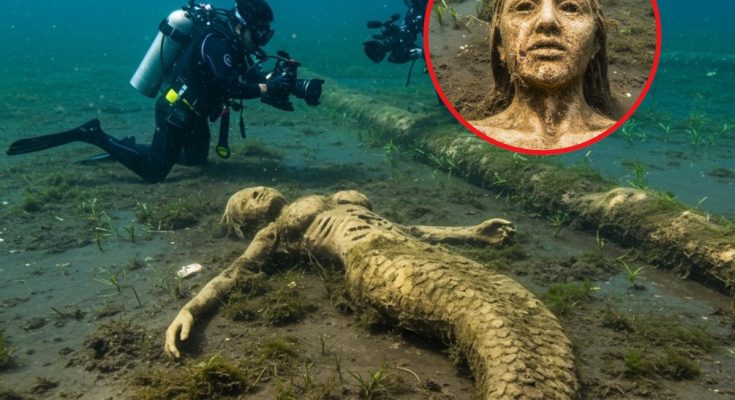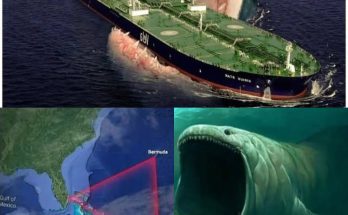The Discovery That Shook the Deep
It began as a routine dive off the coast of Santorini, Greece, where a group of marine archaeologists were surveying an underwater cavern believed to hold remnants of ancient volcanic eruptions. But what they found instead has electrified the world and plunged science into one of its most controversial debates of the century.
Lying eerily still on the ocean floor, partially covered in silt and coral, was a form that seemed to defy classification: a mummified mermaid-like figure.
Divers’ cameras captured images of a body with a strikingly human-like torso and arms, yet extending below the waist was a scaled, finned appendage resembling the tail of a large fish. Its preserved skin, leathery but intact, appeared to shimmer under torchlight, while strands of dark hair floated like seaweed around its skull-like face.
When the divers resurfaced and the footage was shared, the reaction was immediate: disbelief, awe, and viral frenzy.
Viral Explosion
Within hours, hashtags like #MermaidMummy and #OceanSecrets topped global trends. Millions of viewers dissected the blurry but unmistakable footage: the gaping eye sockets, the ribs arching through the skin, the tail curled as though frozen mid-swim.
Comment threads became battlefields. Some hailed it as the long-awaited proof of myths passed down through millennia. Others insisted it was a hoax designed to generate attention or lure tourists.
“Either we just uncovered the find of the millennium,” one user tweeted, “or we’re witnessing the most elaborate prank in human history.”
Experts React

Marine biologists were among the first to weigh in.
Dr. Helena Vargos of the International Oceanic Institute called the discovery “a potential paradigm shift.”
“If authentic, this specimen could represent a previously unknown branch of marine evolution—an intelligent aquatic hominid. It would rewrite biology textbooks overnight.”
But skeptics were quick to push back.
Dr. Alan Prothero, a geneticist from Oxford, dismissed the find:
“Extraordinary claims require extraordinary evidence. Right now we have a video, not proof. It could be a constructed artifact, a composite of human and fish remains designed to mislead.”
Ancient Clues?
Historians note that myths of mermaids—or sea people—span nearly every culture. From the sirens of Greek mythology to Japan’s ningyo and the Mami Wata legends of Africa, stories of hybrid sea beings have persisted for thousands of years.
The location of the discovery—near Santorini, once home to the powerful Minoan civilization—has fueled speculation about ancient worship practices or even genetic experimentation lost to time.
“This could be evidence that myths were not mere imagination, but cultural memory of encounters with beings long forgotten,” said Dr. Lian Zhou, an anthropologist specializing in mythic archetypes.
The Mermaid’s Appearance
Preliminary descriptions from divers reveal a haunting image:
-
The skull is elongated, with hollow sockets where eyes once were.
-
The teeth, sharp and pointed, resemble those of predatory fish rather than humans.
-
The arms and hands are distinctly humanoid, with bony fingers curled as though reaching for something.
-
The tail, measuring nearly six feet, ends in a split fin resembling that of a dolphin.
-
Radiocarbon dating of samples (though unverified) suggest the body could be several hundred years old, preserved by the cold depths and mineral-rich sediment.
One diver admitted, “It looked like it was watching us—even though it had no eyes left. I’ll never forget that feeling.”
Hoax or History?
Skeptics argue the “mermaid mummy” may be an art piece, perhaps planted by locals aware of the tourist draw such a discovery would generate. Others suggest it could be a natural phenomenon: a distorted whale or seal corpse misinterpreted by eager eyes.
Yet believers counter with the physical details: the symmetrical structure of the tail, the spine running seamlessly from torso to fin, and the apparent fusion of human and aquatic anatomy.
“Nature doesn’t lie,” said one diver. “This wasn’t stitched together. It was real.”
Governments Step In
The Greek Ministry of Culture has now sealed off the dive site, citing “archaeological protection laws.” Officials transported the remains to a secure facility in Athens, fueling conspiracy theories that the government intends to suppress or control the truth.
Some activists warn the discovery could be weaponized. “If it’s genuine,” said marine activist Naomi Cruz, “governments will race to claim it, dissect it, and turn it into a tool for power. That’s not discovery—that’s desecration.”
Religious and Cultural Shockwaves
Faith communities worldwide are divided. Some interpret the find as validation of creation stories that speak of sea-born beings. Others denounce it as a distraction or even a deception designed to undermine human uniqueness.
In coastal villages in Africa and the Caribbean, worshippers of sea deities lit candles and held vigils, claiming the mermaid’s resurfacing is a spiritual omen.
Scientists vs. Believers
The debate now stretches far beyond academia. Social platforms are flooded with theories:
-
Evolutionary Missing Link: Was this an aquatic branch of humans who adapted fully to ocean life?
-
Ancient Genetic Engineering: Did advanced civilizations experiment with merging species?
-
Extraterrestrial Hypothesis: Some claim the “mermaid” resembles alien-human hybrids in ancient texts.
-
Elaborate Hoax: Perhaps the simplest answer—that this is a crafted figure designed to trick the world.
The Unbelievable Twist
Just as the controversy peaked, a leaked lab report (unverified) claimed DNA samples from the creature show markers inconsistent with both human and known marine species.
If true, it would mean the body belongs to a creature outside the catalog of Earth’s biology. The leak set the internet ablaze with one question:
What else is hidden beneath the waves?
Beyond Myth and Reality
Whether the mermaid is myth come alive, a fraud exposed, or something in between, one fact is undeniable: the world is paying attention. The discovery has reignited public fascination with the oceans, 80% of which remain unexplored.
As one commentator wrote:
“We’ve mapped the surface of Mars more thoroughly than our own seas. If mermaids—or something like them—exist, what else waits in the dark?”
Epilogue: Waiting for Truth
For now, the mummified mermaid remains locked in a government lab, awaiting peer-reviewed study. Scientists demand transparency. Believers demand recognition. Skeptics demand proof.
And ordinary people, staring at their phones, ask themselves: was the laughter at old sailors’ tales misplaced? Or have we always known, deep down, that myths carry fragments of truth?
Until the official verdict arrives, the world waits, holding its breath like a diver descending into unchart



